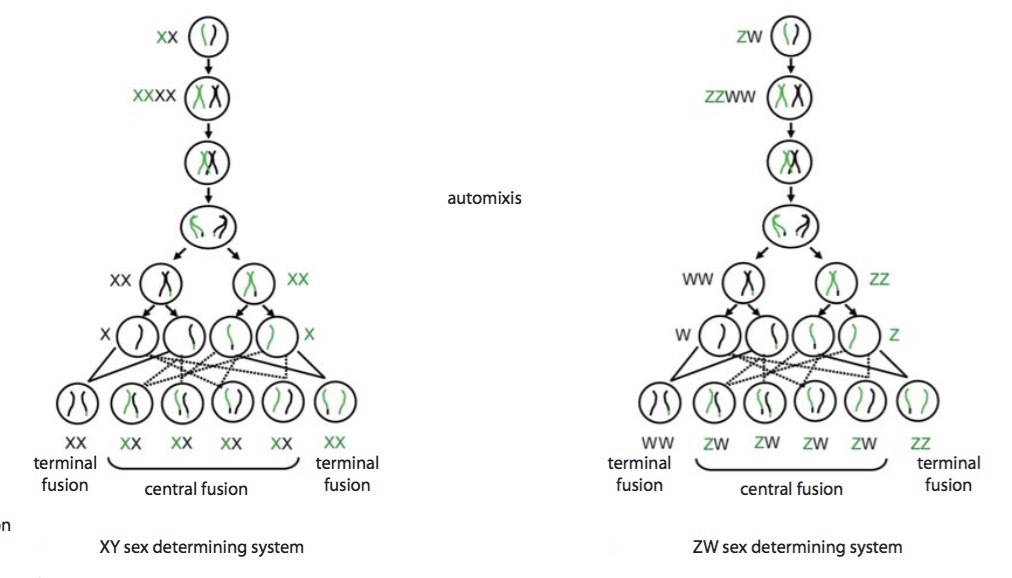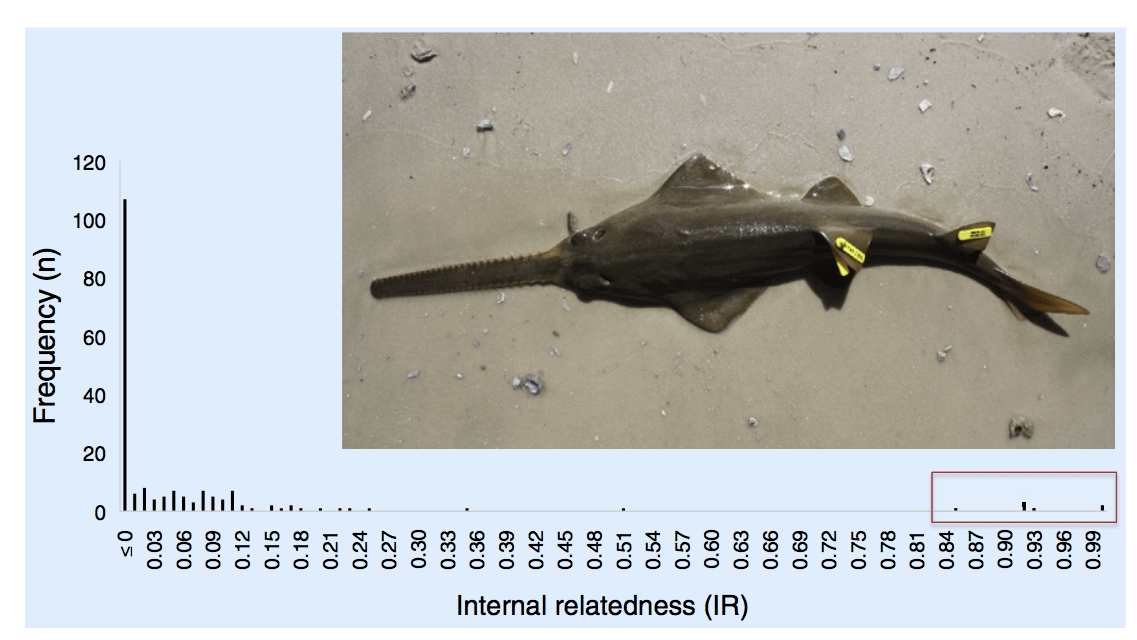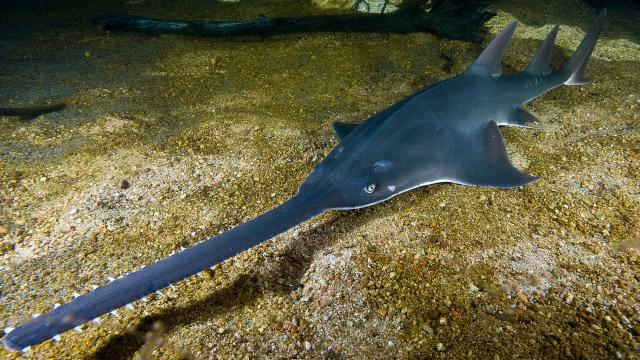The critically endangered smalltooth sawfish was recently found to be capable of asexual reproduction. It’s an exciting discovery for many reasons, but breathless claims by the media that sawfish could save their species from extinction by resorting to virgin births are wrong, wrong, wrong. Let’s explore why.
For those who missed the news: A couple of weeks ago, a group of ichthyologists announced it had discovered several wild sawfish who were effectively clones of their mothers. It was a highly unusual observation — and an accidental one, at that. Smalltooth sawfish numbers have been crashing for a decade (there may be only around 600 of these animals left in the United States), and SUNY Stony Brook Ph.D. student Andrew Fields had collected genetic samples to test whether or not they were getting inbred. Most of the fish he sampled weren’t. But seven fish had genetic fingerprints that showed they had only one parent. They had no father, and had developed from their mother’s unfertilized eggs.
This was exciting for a bunch of reasons. First of all, this type of asexual reproduction — parthenogenesis — had only been documented in wild animals once before. Second, this was the first time parthenogenesis had been identified in this particular species. Third, the seven (seven!) smalltooth sawfish weren’t all clones of the same individual, which meant that more than one female was using parthenogenesis, and that’s really really super damn cool.
But when it hit the internet, that wasn’t the lesson some news outlets took. Papers blared that sawfish “resort to virgin births” to “cheat extinction” and save the species. And that’s bullshit. Parthenogenesis is not going to save a species from extinction. To explain why, I’ll need to first explain how parthenogenesis works. And then we can talk about why it isn’t the best method to rebuild an endangered group of animals.
What is Parthenogenesis, And How Does It Work?
They’re not invoking Jesus when they call it a “virgin birth” — that’s what the Greek for parthenogenesis literally means (‘partheno’ = virgin; ‘genesis’ = beginning). It’s a form of asexual reproduction, where females make their babies from unfertilized eggs. Some animals — like the very odd bdelloid rotifers — only reproduce by parthenogenesis. But for most parthenogenetic females, solo-reproduction is an option, not a biological mandate. Sexual females who can resort to asexual procreation are said to exhibit “facultative” parthenogenesis.
Most of the parthenogenesis that goes on in vertebrates is of the facultative flavour. And that actually leads to a problem for the birds, lizards, snakes, and sharks that sometimes do it. Vertebrate cells need two full sets of chromosomes inside the nucleus if they’re going to work — they need to be diploid. But the process of turning ovarian stem cells into eggs, a form of cell division called meiosis, splits up chromosomes so that the egg holds only one full chromosome set. The egg is haploid, so if a female vertebrate is going to grow some parthenogenetic offspring, she’ll need to find a way to double up the chromosomes inside her eggs.
There are two possible ways to accomplish that feat. The egg might stop meiosis halfway through the process, staying diploid by avoiding the last division of chromosomes. Vertebrates that use this process, like the fully parthenogenetic Amazon molly (Poecilia formosa), give birth to nothing but daughters, each one a clone of her mother. (Interestingly, the Amazon molly has to have sex with a male from a related sexual species to make her eggs start developing, so she’s not strictly a ‘virgin’ when she creates her clones.)
Alternatively, after the egg forms normally by meiosis it can fuse with one of the tiny haploid polar bodies that was thrown off during the process. The polar body plays the same role a sperm cell would have, except that it’s carrying a set of the mother’s chromosomes. Here’s where things get a little crazy. Chromosomes get shuffled around during meiosis, so the re-fusion of mum’s genetic material can make the offspring a “half clone’ of its mother. If you imagine that the mother’s chromosomes are all AB pairs, her parthenogenetic baby may wind up with a mix of AB, AA, and BB chromosome sets. This style of parthenogenesis, called automixis, can even produce males in species where (as in snakes and lizards) females have two different sex chromosomes (ZW) and males have paired sex chromosomes (ZZ).

How automixis works in both XY and ZW sex determination systems. (Lampert 2008)
Facultative Parthenogenesis is More Common Than We Used to Think
Until very recently, we only saw facultative parthenogenesis in snakes, lizards, and fish living in zoos and aquariums. In one well-publicised case in 2001, a hammerhead shark at a Nebraska zoo gave birth to a single pup even though she had been caught when she was still immature and had no contact with males for three years. In another, Komodo dragons in two English zoos laid viable eggs in the absence of males. For both the shark and the Komodo dragon, subsequent genetic analysis confirmed that the babies were parthenogenetic offspring: the sort of near-clones of their mother that would be expected from automixis.
Since we had never seen this type of near-clone in the wild, a lot of biologists assumed that when parthenogenesis appeared in an otherwise sexual species it was a weird-arse kind of fluke that came from keeping animals in captivity. But in 2012, biologists working with Zoo Atlanta reported that they had snakes that were wild-caught while pregnant (yes, some snakes get pregnant) who had given birth to parthenogenetic sons. Add this new observation in wild-caught sawfish, and it starts to seem like parthenogenesis could be a much more common style of making babies than we thought.
Why didn’t we notice sooner? It’s simple: we couldn’t really study the phenomenon until we had a way to look closely at an animal’s genes. Earlier genetic methods needed to compare mother and child — easy data to get from captive animals, but nearly impossible to get from wild species when they don’t stick around to take care of their babies. The method Fields’ used on the sawfish doesn’t depend on having the mum around: it compares chromosome pairs inside an animal to see how similar they are. If an animal receives one chromosome in a pair from its mum and the other from its dad, the chromosomes should have many differences and their “relatedness” will be near zero. If mum and dad were siblings or close cousins, their offspring’s chromosomes will have fewer differences, and a relatedness between 0.25 and 0.5. Keep that in mind when you look at the image below: the parthenogenetic sawfish pop out in the analysis because the genes on each of their chromosomes are nearly identical — their relatedness is nearly 1.0.

Internal relatedness (chromosome similarity) in the smalltooth sawfish. Completely dissimilar chromosomes would have a value of 0.0. Identical chromosomes would have a value of 1.0 (from Fields et al. 2015)
Facultative Parthenogenesis is Still Rare And Can’t Prevent Extinction
I’m thrilled to live on a planet where there are parthenogenetic sawfish. And I’m betting that when Fields’ screening method is tried on more wild populations of animals, we’ll find other species that can be parthenogenetic. But let’s not lose our heads about it. Just start by looking at that image where the near-clones pop out of the analysis. Look over to the left of the graph: the vast majority of the sawfish Fields surveyed still had a mum and a dad. Of the 190 fish the researchers caught for their study, only seven were found to be parthenogenetic babies — and five of those were siblings. Can a parthenogenetic ratio this measly really save a highly endangered species? I doubt it.
There’s another problem, too. An endangered species repopulated by just a few clones, or even near-clones, would eventually sacrifice a great deal of genetic diversity. The consequences could be dire: if a new disease comes along that one of the founding mothers was susceptible to, it could spread through her descendants like wildfire, destroying a much larger chunk of the species than would have been affected in a more diverse, mixed up sexual species.
Sex has its drawbacks: animals competing for mates can harm one another or get so distracted that they get eaten by predators, and mates can pass on sexually transmitted diseases. And there’s always a chance that some offspring will be saddled with less-than-ideal combinations of genes. But it also lets animals hedge their bets. So even if a few sawfish, for whatever unknown reason, try out the parthenogenesis experiment, we should be glad that most of the population is making babies the usual way. Then we can focus on the hard work of preserving their habitat and stopping illegal fishing, instead of hoping that some virgin birth will let them save themselves.
[Short and Balaban 1994, Simon et al. 2003, Watts et al. 2006, Chapman et al. 2007, Lampert 2008, Neaves and Bauman 2011, Booth et al. 2012, Jordan et al. 2014, Fields et al. 2015]
Picture: Simon Fraser University via Flickr
